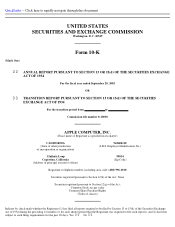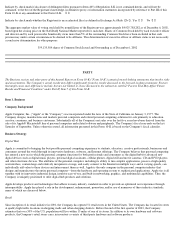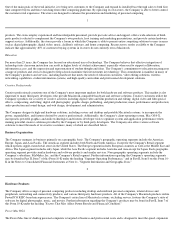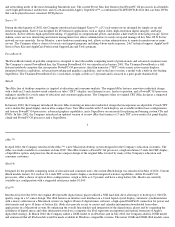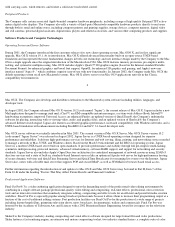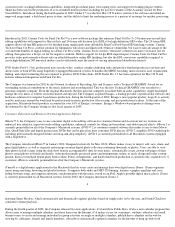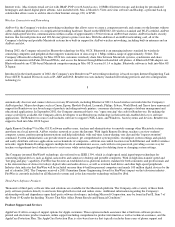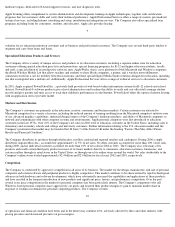Apple 2002 Annual Report Download - page 12
Download and view the complete annual report
Please find page 12 of the 2002 Apple annual report below. You can navigate through the pages in the report by either clicking on the pages listed below, or by using the keyword search tool below to find specific information within the annual report.
Although the Company believes the ownership of such patents, copyrights, trademarks and service marks is an important factor in its business
and that its success does depend in part on the ownership thereof, the Company relies primarily on the innovative skills, technical competence,
and marketing abilities of its personnel.
Many of the Company's products are designed to include intellectual property obtained from third parties. While it may be necessary in the
future to seek or renew licenses relating to various aspects of its products and business methods, the Company believes that based upon past
experience and industry practice, such licenses generally could be obtained on commercially reasonable terms. Because of technological
changes in the computer industry, current extensive patent coverage, and the rapid rate of issuance of new patents, it is possible certain
components of the Company's products and business methods may unknowingly infringe existing patents of others. The Company has from
time to time been notified that it may be infringing certain patents or other intellectual property rights of others.
Information regarding claims and litigation involving the Company related to alleged patent infringement and risks related to the Company's
reliance on third-party intellectual property is set forth in Part I, Item 3 of this Form 10-K, and in Part II, Item 7 of this Form 10-K under the
heading "Factors That May Affect Future Results and Financial Condition."
Foreign and Domestic Operations and Geographic Data
The United States represents the Company's largest geographic marketplace. Approximately 57% of the Company's net sales in fiscal 2002
came from sales to customers inside the United States. Final assembly of products sold by the Company is conducted in the Company's
manufacturing facilities in Sacramento, California, and Cork, Ireland, and by external vendors in Fullerton, California, Taiwan, Korea, the
People's Republic of China, and the Czech Republic. Margins on sales of Apple products in foreign countries, and on sales of products that
include components obtained from foreign suppliers, can be adversely affected by foreign currency exchange rate fluctuations and by
international trade regulations, including tariffs and antidumping penalties.
12
Information regarding financial data by geographic segment is set forth in Part II, Item 8 of this Form 10-K in the Notes to Consolidated
Financial Statements at Note 11, "Segment Information and Geographic Data." Additional information regarding the risks associated with
international operations is set forth in Part II, Item 7 of this Form 10-K under the heading "Factors That May Affect Future Results and
Financial Condition."
Seasonal Business
Although the Company does not consider its business to be highly seasonal, it has historically experienced increased net sales in its first and
fourth fiscal quarters, compared to other quarters in its fiscal year, due to seasonal demand related to the holiday season and the school year.
However, over the past two years the Company has not experienced these seasonal fluctuations in net sales due to the negative impact of
current economic conditions on the overall demand for the Company's products. Past performance should not be considered a reliable indicator
of the Company's future net sales or financial performance.
Warranty
The Company offers a limited parts and labor warranty on its hardware products. The warranty period is typically one year from the date of
purchase by the end user. The Company also offers a 90-day warranty for Apple software and for Apple service parts used to repair Apple
hardware products. In addition, consumers may purchase extended service coverage on most Apple hardware products in all of the Company's
major markets.
Backlog
In the Company's experience, the actual amount of product backlog at any particular time is not a meaningful indication of its future business
prospects. In particular, backlog often increases in anticipation of or immediately following new product introductions because of over ordering
by dealers anticipating shortages. Backlog often is reduced once dealers and customers believe they can obtain sufficient supply. Because of the
foregoing, backlog should not be considered a reliable indicator of the Company's ability to achieve any particular level of revenue or financial
performance.
Environmental Laws
Compliance with federal, state, local, and foreign laws enacted for the protection of the environment has to date had no material effect upon the
Company's capital expenditures, earnings, or competitive position. Although the Company does not anticipate any material adverse effects in
the future based on the nature of its operations and the subject of these laws, there is no assurance that such existing laws or future laws will not
have a material adverse effect on the Company.


